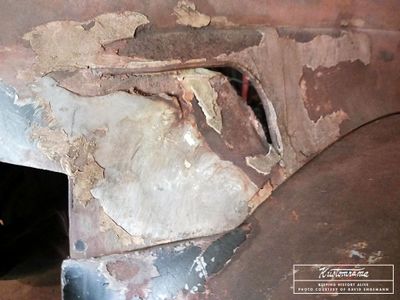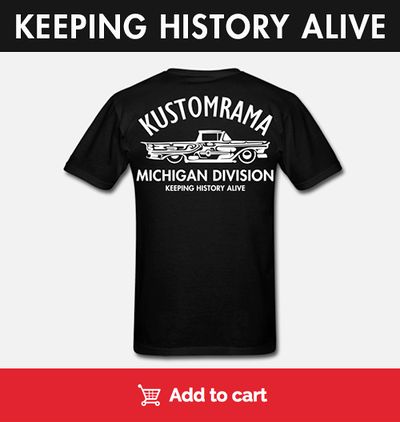David Engemann's 1939 Ford Convertible - The Dream Catcher













1939 Ford Convertible owned by David Engemann of West Branch, Michigan. Affectionately named the "Dream Catcher," Engemann's Ford is a unique custom that embodies the creativity and craftsmanship of several decades of automotive history. Rescued from a dilapidated state in Michigan, this car represents Engemann's dedication to preserving custom automotive culture and the imagination, hopes, and dreams of previous owners and builders. Its story weaves through time, blending influences from the 1940s and 1950s with remnants of both early and mid-century custom car trends. Below is a detailed account of this vehicle's history, notable features, and the passion driving its current restoration.
Contents
Origins and Acquisition: A Rough Diamond
David Engemann's journey with the '39 Ford began when his friend Scott spotted the car on a Neighbor Yard Sale website while having breakfast one Saturday morning. "LOOK! A '39 Ford Convertible," Scott exclaimed, prompting David to take action immediately. The car was located in North Muskegon, Michigan, and had changed hands several times before it found its way into David's possession.[1]
Scott tracked down the seller, Ross Ruiz, and his father, Raul, who had purchased the car from Wayne Sampson of Escanaba, Michigan, located in the Upper Peninsula. Sadly, the car had been passed around and neglected, leaving it in rough condition. "It's pretty rough," David told Sondre Kvipt of Kustomrama, "Sad when a car gets passed around like this." Despite its state, David saw potential in the project, driven by the belief that the car could still run and drive. His philosophy? "My goal is to do no harm and enjoy it for what it is."[1]
In early 2025, David was able to trace the car’s story back even further. After some digging, he located Dan Sampson, the brother of the late Wayne Sampson, who confirmed that Wayne had acquired the Ford from Kentucky. According to Dan, the car was hauled up to Escanaba in 1982, where it sat outdoors for the next four decades. Dan described his brother as a pack rat who loved to collect all kinds of things, including old cars. The brief phone call offered a key clue into the car’s long-lost past, suggesting that the Dream Catcher had spent over 40 years resting under Michigan skies before it began its next chapter with Ross. “Hauled from Kentucky in 1982 by his brother. That’s quite a story,” David noted.[1]
A Tribute to Custom Legends: The Westergard Influence
David's Convertible appears to be inspired by a legendary 1939 Ford Custom designed by Harry Westergard for Mel Falconer in 1945. Westergard, a pioneer in the early custom car scene, was renowned for his elegant modifications, often blending luxury car components into otherwise ordinary vehicles. The original Westergard car was later owned by Bruce Glenn and featured in Rod & Custom May 1954.[1]
David's car exhibits several cues that are strikingly similar to the Westergard design but with influences from the mid to late 1950s. "There are several styling features that aren't my first personal choice. But history is history and I can't change history," David reflected. Despite its incomplete state and mismatched modifications over the years, David is determined to honor the vehicle’s custom heritage.[1]
Unraveling the Modifications: A 1950s Custom Time Capsule
David discovered several fascinating details during his inspection of the car, pointing to its past customization, which David believes was done in the early 1950s. David believes the featured story of Mel Falconer's 1939 Ford Convertible in Rod & Custom May 1954 might have been the initial inspiration for the build. Among the first clues was a 1949 Ford window crank handle found on the passenger door—a piece of hardware that David had used in many of his own builds. This handle, along with other period-correct accessories like 1949 Ford choke knobs on the dashboard, suggested that the car had undergone customization in the post-war years.[1]
One of the most notable features is the chopped top. The top of the car, originally intended as a convertible, appears to have been an attempt at converting it into a hardtop using a postwar Chevrolet coupe top—another customization trend of the time. The windshield garnish molding had been cut down and chromed, and parts of the interior trim bore signs of chroming as well. The car's exterior tells a story of significant, though incomplete, modifications. The front features a grille sourced from a 1941 Packard, while the rear showcases frenched 1950 - 1952 Buick taillights—a signature custom touch from the 1950s that involves embedding the lights deeper into the body. All four fenders have been molded to the body with lead, a testament to the craftsmanship of early customizers, though some of the later modifications using bondo were less impressive. The rear fender openings had also been modified, likely with 1956 Chevrolet components.[1]
Rust, Restoration, and Revelations
While David appreciates the artistry and history behind the modifications, the condition of the car presented significant challenges. The floor had rusted out completely from the front all the way to the rear seat riser. "Rust doesn't end there," David noted, as the rumble seat floor and the area over the gas tank were in equally poor shape. However, he was pleasantly surprised to find that the rear tool box area was in good condition—one of the many small victories in the restoration process.[1]
Another interesting discovery came from the rumble seat cushion. The burlap and batting were in decent shape, but the springs were a modern zig-zag design, suggesting that some of the interior components had been replaced with parts from a later vehicle. "I'm positive the originals were coil springs," David remarked, further highlighting the patchwork nature of the car’s past.[1]
The Road Ahead: A Dreamer’s Dedication
David is committed to restoring the Dream Catcher. His approach is respectful of the car’s past while focusing on making it a running and driving piece of history. "It will run and drive again," David declared, despite the car's rough condition. "This car will be a tribute to all the builds, complete and incomplete, that went to scrap yards."[1]
He continues to work on the car in his garage, collecting parts and making careful restorations while preserving the integrity of its unique custom history. His vision for the Dream Catcher is one of appreciation, not perfection. "There are several styling features that aren’t my first personal choice," David admitted, "but history is history, and I can't change history." At 78 years old, David draws on the support of friends like Scott, who visits regularly to help and keep him motivated. "Scott keeps me going and fired up," David said, acknowledging that at his age, having a friend to share the project with is invaluable.[1]
David Engemann's 1939 Ford Convertible, the Dream Catcher, stands as a living testament to the ingenuity and passion of custom car builders from decades past. With roots tracing back to the early post-war custom scene, this car carries with it the dreams of its previous owners and the craftsmanship of small, independent body shops that left their mark on it. David’s meticulous approach to restoration, driven by his respect for its history, ensures that the Dream Catcher will not only be saved from further neglect but will also continue to inspire future generations of car enthusiasts. In David’s words: "This will never truly be mine because it represents the imagination, hopes, and dreams of others."[1]
Tracing the History of the Dream Catcher
While David Engemann has uncovered many fascinating details about his 1939 Ford Convertible, the Dream Catcher, much of its early history remains shrouded in mystery. The car has clearly passed through several hands, undergoing various customizations along the way, but little is known about its origins or the people who shaped its evolution. David believes that the car's customization dates back to the 1940s and the early 1950s, with features like the 1949 Ford hardware, the chopped top, and the lead-molded fenders pointing to a classic post-war custom build.
In early [[2025[[, a major piece of the puzzle surfaced. David was able to track down Dan Sampson, the brother of the late Wayne Sampson of Escanaba, Michigan. In a brief phone call, Dan confirmed that Wayne had acquired the car from Kentucky and hauled it north in 1982. The Ford then sat outside on Wayne’s property for the next 40 years. Dan described Wayne as a collector who enjoyed saving old vehicles, keeping many of them on hand in a private junkyard.
Yet, despite this promising lead, many questions remain unanswered: Who customized the car originally? What inspired the unique blend of styling cues, like the 1941 Packard grille and the headlights? And what stories did it gather during its unknown decades before Escanaba?
If you have any information about this car, or if you recognize any of its distinctive modifications from an old shop, photo, or show memory, Kustomrama would love to hear from you. Perhaps you've seen the Dream Catcher in a forgotten snapshot, recall it tucked behind a garage, or remember someone working on a car like it in Kentucky or Michigan decades ago.
David's mission is not only to restore the Dream Catcher—but to restore its story. With your help, this unfinished custom may finally get the recognition and remembrance it deserves. If you can help piece together its past, please reach out to Kustomrama at mail@kustomrama.com.
The Dream Catcher represents the imagination and labor of builders long gone. Let’s keep their story alive.
References
Did you enjoy this article?
Kustomrama is an encyclopedia dedicated to preserve, share and protect traditional hot rod and custom car history from all over the world.
- Help us keep history alive. For as little as 2.99 USD a month you can become a monthly supporter. Click here to learn more.
- Subscribe to our free newsletter and receive regular updates and stories from Kustomrama.
- Do you know someone who would enjoy this article? Click here to forward it.
Can you help us make this article better?
Please get in touch with us at mail@kustomrama.com if you have additional information or photos to share about David Engemann's 1939 Ford Convertible - The Dream Catcher.
This article was made possible by:
SunTec Auto Glass - Auto Glass Services on Vintage and Classic Cars
Finding a replacement windshield, back or side glass can be a difficult task when restoring your vintage or custom classic car. It doesn't have to be though now with auto glass specialist companies like www.suntecautoglass.com. They can source OEM or OEM-equivalent glass for older makes/models; which will ensure a proper fit every time. Check them out for more details!
Do you want to see your company here? Click here for more info about how you can advertise your business on Kustomrama.






